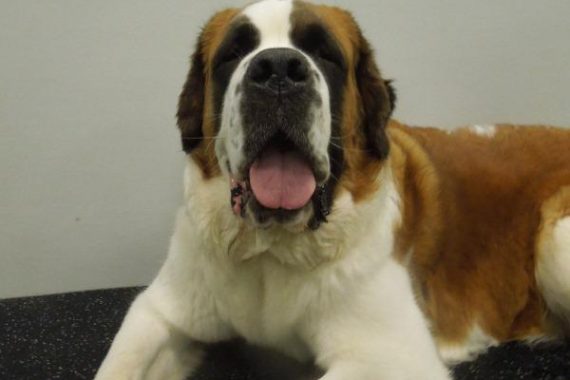5 Reasons Why a St. Bernard May Be the Perfect Breed For You

You’ve probably seen the clichéd image of St. Bernards: those big, lovable dogs wearing a barrel of brandy around their neck while saving people trapped in snowstorms. But there is more to this breed than pop culture references may suggest. Here are five reasons why St. Bernards (or, as they are nicknamed, Bernies) could be the perfect dog for you:
History
Originating from Roman Molossian dogs, the St. Bernard (originally called Alpine Mastiffs) first rose to fame in the late 1600s as helpers for people at the Great Saint Bernard Hospice, located in the Pennine Alps between Switzerland and Italy. They were originally work animals, used to pull carts and act as watch dogs in this remote location. However, it was soon discovered that they could locate lost snowbound travelers and revive them by either licking their face or cuddling up beside them to create warmth.
The idea of Bernies wearing a neck barrel likely originated from a 19th century painting called Alpine Mastiffs Reanimating a Distressed Traveler by Edwin Landseer, which features the image of two St. Bernards carrying barrels of what was apparently brandy. The image stuck, and to this day, St. Bernards continue to appear with those barrels around their neck in everything from commercials to cartoons.
Size
The original St. Bernards were built more like today’s German Shepherds. Leaner and shorter, they had a thinner, reddish-brown coat and a longer tail than the modern Bernie. To increase their size, they were eventually bred with Newfoundlanders.
Today’s St. Bernards have an average weight of between 120 and 280 pounds and a height between 26 and 30 inches. This large frame means that they will take longer to mature to their adult size, some only reach their full size when they are over 2 years old.
Intelligence
Like most working breed dogs, St. Bernards are smart and quick to learn. They typically need just 15 minutes of training a day to learn the basic tasks and have a quick understanding of one or two syllable training words.
Because of their large size, the key is to train them early, especially if they are going to be spending time inside your house. You want them to quickly learn the areas that are off limits and become a well-mannered pup that isn’t always inadvertently knocking things (or people!) over.
Temperament
Not only are St. Bernards smart, they are also eager to please and love spending time with large groups. They are so eager to be around people, they may actually sulk if they feel like they are being left out.
Their sheer size and the sound of their barks can make Bernies a really good watchdog. They are also fiercely protective of those they love. Their intense desire to please their owners usually makes them easy to train and ideal house protectors.
Activity Level
Keep in mind that the breed was originally raised outside so they do enjoy their outdoor playtime. During the summer, their thick coat will make them feel extreme heat more than you may realize. A small wading pool filled with enough water to cover their paws will help then stay cool during those hot temperatures.
Because of their large size, activity is key to ensuring they stay a healthy weight, which keeps their hips and elbows from straining as they get older. A few daily sessions of fast-paced walks or runs should ensure their weight stays under control. If you do not have the time to take your Bernie out for exercise, consider enrolling them at a dog daycare facility like Dogtopia, where they will enjoy hours of safe, open-play fun.











